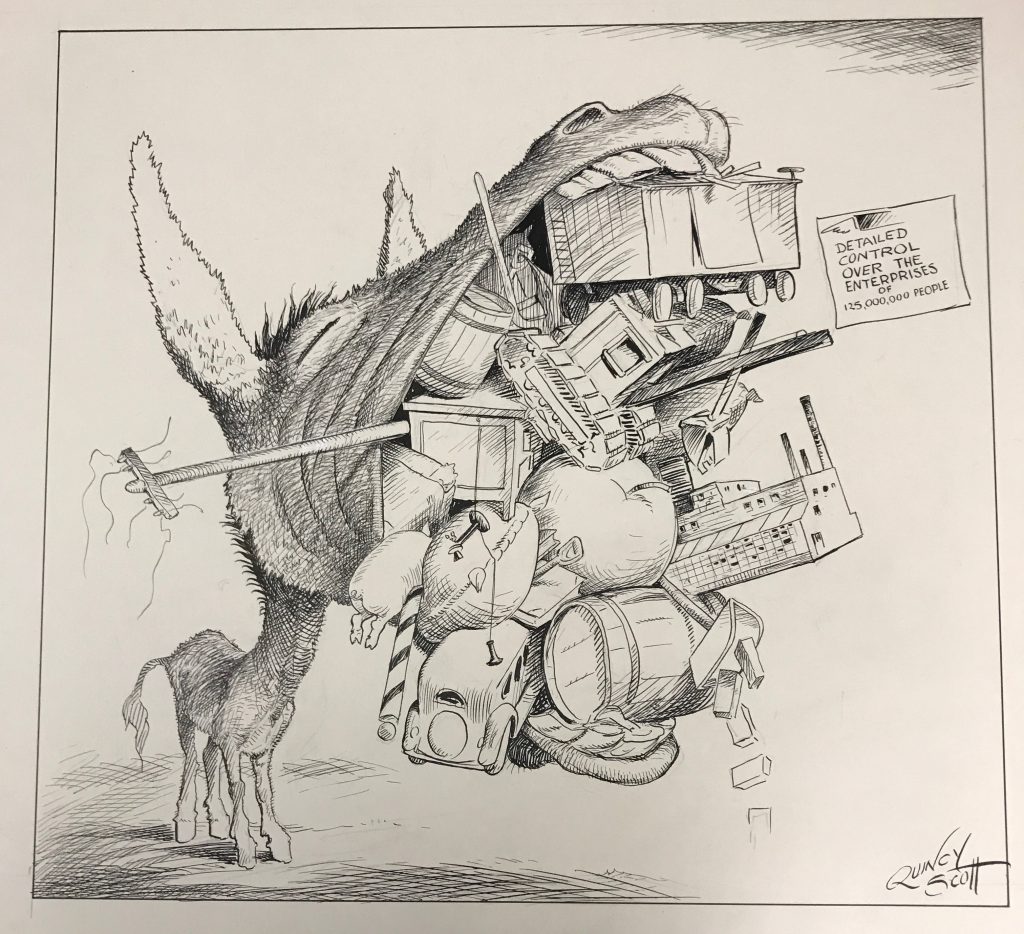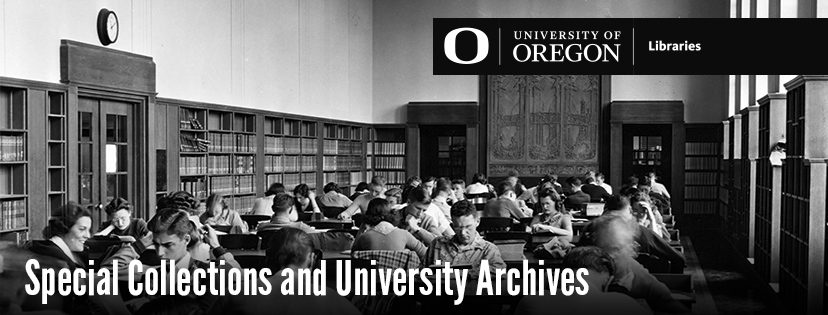Processing the Quincy Scott Political Cartoons
Special Collections and University Archives is currently processing and writing a finding aid for the Quincy Scott collection of twentieth century political cartoons (GA Sc 85). This project was generously supported through an LSTA grant and will also include digitization of a selection of cartoons through the assistance of UO Libraries’ Digital Scholarship Services. This archival and digital collection will provide access to Oregonian political and social perspectives during the Great Depression and World War II through the humor and wit of political caricature. A future blog post will announce when the collection is fully processed and available to the public.

Portland resident Quincy Scott (1882-1965) was the editorial cartoonist for The Oregonian from 1931-1949 and this collection includes original artwork produced during his tenure at the newspaper, comprised of over 4,600 almost daily political cartoons. Scott was a faithful member of the Republican Party and his cartoons strongly reflect his personal stance on local, national, and international political topics, though Scott’s son/biographer notes that these opinions did not always fully align with those of the newspaper’s general editorial team. These cartoons illustrate early twentieth century life and politics in Oregon and will be particularly of interest to those researching the history of critical or conservative receptions of Depression-era legislation. Some of Scott’s frequently illustrated subjects will be highlighted in this post.
FDR and the New Deal


Scott’s cartoons often depict national political issues with passionate critiques of expensive New Deal economic policies that weren’t centered on balancing the budget. The cartoons demonstrate the artist’s serious misgivings the huge cost and expansive power of the many federal projects, or alphabet agencies, sponsored by the Roosevelt administration. Such critiques were levied at federal control over individual liberties, such as the 1933 Farm Relief Bill, or Agricultural Adjustment Act, that aimed to control commodity surpluses and prices during the Great Depression, but disproportionately benefited large-scale farmers (the bill’s taxation method was later ruled unconstitutional and adjusted). Scott also illustrated his misgivings on other national political issues, such as FDR’s controversial court-packing bill and FDR’s choice to pursue a third term as President.

Criticism of the Roosevelt administration in the cartoons begins to lessen with the start of U.S. involvement in the Second World War. During this time, Scott had his only hiatus from the paper when he left in 1941 to serve in the U.S. Army in the Editorial Division of the Morale Operations Branch in Washington, D.C. Upon his return to Portland in 1942, after reaching the mandatory separation age, the subject of his cartoons instead promote unity and attempt to rally the community in support of the war effort through home front activities like starting victory gardens and buying war bonds.
Pacific Northwest Industry and Leadership

The cartoons also discuss similar political issues in Portland and the Pacific Northwest, including commentary on mayoral and gubernatorial elections, congressional sessions, and education. Scott documented the successes and failures in prominent Northwest industries such as lumber, fishing, and agriculture. The cartoons especially take note of perceived political threats to the success of these industries, such as the still-persistent trade dispute surrounding cheaper Canadian lumber imports.

Scott did not condemn all New Deal projects, which is most evident in his illustrations that praise the proposal and construction of the Bonneville Dam between 1933 and 1937, which he saw as a boon to jobs, power, and new industry, such as aluminum smelting. A few cartoons also acknowledge some of the environmental consequences of such a project, such as its impact on salmon harvesting and the need for fish ladders.
Portland Infrastructure
The collection also documents the changing landscape and infrastructure of Portland and Oregon as it grew during the period. Cartoons note improvements to highway travel, including better access to the coast, as well as looking ahead to future projects. For example, they illustrate the city’s anticipation of future larger aircrafts and the need to select an appropriately sized site for a new “super airport,” documenting the move from its initial location on Swan Island to its present location at Port of Portland.


Additionally, many cartoons discuss the urban environment of Portland, and researchers may find visual annotations in the history of Portland housing such as the emptying out of Hoover-era shantytowns and N.H.A. housing projects to support the influx of shipbuilders during the war. Scott also documents the development of reorganized roads, signage, and traffic controls. Throughout his career Scott was especially attentive to the large number of automobile deaths and sought to advocate safer driving habits and improved infrastructure and traffic control.
Democratic and Social Ideals

The daily cartoons are also frequent calls-to-action for his audience to fulfill ideal notions of civic duties which included filing taxes promptly, renewing state license plate registration, and the voter’s responsibility to go out and cast an informed vote on election days. Scott used his daily cartoon to lead city-wide charitable contribution campaigns such as giving blood to the Red Cross during wartime and giving money to the Sunshine Division and Milk Fund during the holidays, both food relief programs sponsored by the Portland Police Bureau and Portland Fire Department respectively. As a member of the media, Scott was an advocate for a free press and drew cartoons on this subject in response to news of international media suppression, such as the infamous examples of press restrictions imposed by Hitler and Propaganda Minister Goebbels in Nazi Germany.
Oregon Leisure

While producing cartoons nearly every day on serious, and sometimes grave, political matters, Scott also allotted time for play and respite with an annual vacation and by occasionally drawing more lighthearted cartoons. Many cartoons depict favorite outdoor activities found in Oregon from skiing at Mt. Hood to swimming at the coast. Scott’s appreciation for the outdoors caused him to press the community to clean up a polluted Willamette River as early as 1933, making his work part of a long history of efforts to keep this river unpolluted. Lastly, the passing of the year and routine of the individual Oregonian is documented in illustrations of annual civic events and celebrations such as the Portland Rose Festival and the Pendleton Round-Up.

–Alexa Goff, Archival Processing and Social Media Intern
Further reading:
Scott, Quincy, and Scott, Hugh A. The Best of Quincy Scott: A Picture Panorama of the Turbulent Depression and World War II Years. Portland, Or.: Oregon Historical Society, 1980.

